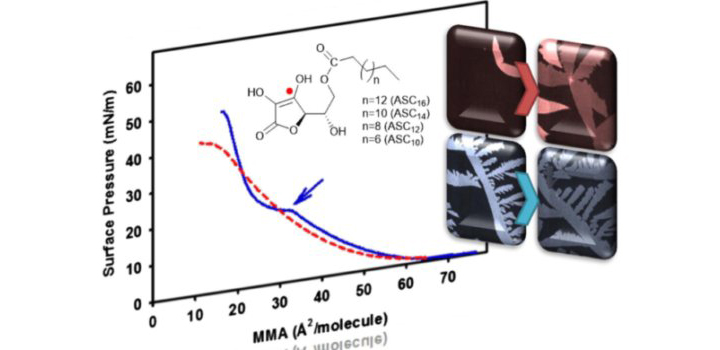Mottola et al. 2015, J Colloid Interface Sci
L-ascorbic acid alkyl esters (ASCn) are molecules of pharmaceutical interest for their amphiphilic nature and proposed antioxidant power. In contrast to L-ascorbic acid, ASC(n) with different acyl chain lengths behaved stably upon oxidation and a tautomeric isomerization was observed. In Langmuir films, when the ascorbic ring has a negative charge, ASC14 and ASC16 form stable monolayers, contrary to ASC10 and ASC12. ASC16 films showed transition from liquid-expanded (LE) to liquid-condensed phase, whereas ASC14 showed only an LE phase. When ASCn are mainly neutral, ASC14 showed phase transition from LE to a crystalline phase, as previously reported for ASC16. The two-dimensional domains displayed crystal-like shapes with anisotropic optical activity when interacting with the polarized light under Brewster angle microscopy. The compounds with the longer acyl chain (ASC16, ASC14 and ASC12) exhibited good surface activity, forming Gibbs monolayers. They also were able to penetrate into phospholipid monolayers up to a critical point of 45-50 mN/m. The 1-palmitoyl-2-oleoylphosphatidylcholine/ASCn films showed LC and/or crystalline domains only for ASC16. This study provides valuable evidence regarding the stability and surface properties of this drug family, and casts light into the differential interaction of these drugs with lipid membranes, which is important for understanding its differential pharmacological activity.
Autores: Mottola M, Vico RV, Villanueva ME, Fanani ML
Artículo: Mottola et al, J Colloid Interface Sci. 2015 Jul 10;457:232-242. doi: 10.1016/j.jcis.2015.07.014.



